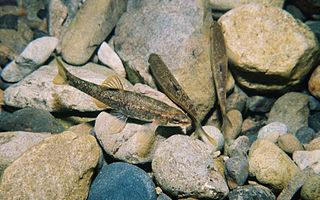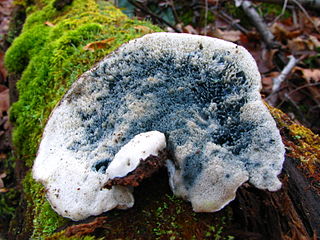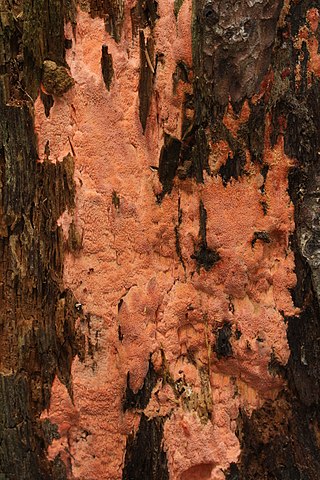
Eleotridae is a family of fish commonly known as sleeper gobies, with about 34 genera and 180 species. Most species are found in the tropical Indo-Pacific region, but there are also species in subtropical and temperate regions, warmer parts of the Americas and near the Atlantic coast in Africa. While many eleotrids pass through a planktonic stage in the sea and some spend their entire lives in the sea; as adults, the majority live in freshwater streams and brackish water. One of its genera, Caecieleotris, is troglobitic. They are especially important as predators in the freshwater stream ecosystems on oceanic islands such as New Zealand and Hawaii that otherwise lack the predatory fish families typical of nearby continents, such as catfish. Anatomically, they are similar to the gobies (Gobiidae), though unlike the majority of gobies, they do not have a pelvic sucker.
Collared wrigglers are perciform fishes in the family Xenisthmidae. They are native to the Indian and Pacific Oceans, where they are mostly reef-dwelling.

The speckled dace, also known as the spotted dace and the carpita pinta, is a member of the minnow family. It is found in temperate freshwater in North America, from Sonora, Mexico to British Columbia, Canada.

Julius Oscar Brefeld, usually just Oscar Brefeld, was a German botanist and mycologist.

The Fomitopsidaceae are a family of fungi in the order Polyporales. Most species are parasitic on woody plants, and tend to cause brown rots. The name comes from Fomitopsis + -aceae.

Oligoporus is a genus of fungi in the family Polyporaceae. The genus was circumscribed by German mycologist Julius Oscar Brefeld in 1888 with Oligoporus farinosus as the type. This species is currently known as Postia rennyi. The genus name combines the Ancient Greek words ὀλίγος ("few") and πόρος ("pore").
Xenisthmus polyzonatus is a species of fish in the Xenisthmidae (wriggler) family, which is regarded as a synonymous with the Eleotridae... It is found in the Indo-Pacific, from the Red Sea to Samoa, north to the Ryukyu Islands.

Xenisthmus is the most well-known genus in the family Xenisthmidae, which is regarded as a synonymous with the Eleotridae, a part of Gobiiformes. These small to very small fish are known as wrigglers, and live in reefs and among rubble in the Indo-Pacific.
Xenisthmus balius is a species of fish in the Xenisthmidae (wriggler) family, which is regarded as a synonymous with the Eleotridae,. It is found in the Persian Gulf.
Xenisthmus africanus, also known as the flathead wriggler or African wriggler, is a species of fish in the Xenisthmidae (wriggler) family, which is regarded as a synonymous with the Eleotridae,. It is found in the Indian Ocean, ranging from the coast of east Africa and to the islands in the western Indian Ocean. It has a flatter head than most other wrigglers.

Xenisthmus clarus, better known as the clear wriggler, is a species of fish in the Xenisthmidae (wriggler) family, which is regarded as a synonymous with the Eleotridae.
Xenisthmus chi is a species of fish in the wriggler family, Xenisthmidae, which is regarded as a synonymous with the Eleotridae,. Japan wrigglers are tiny and clear. Before Paedocypris progenetica and the dwarf goby were discovered, the Japan wriggler was the smallest known fish.
Xenisthmus eirospilus, the spotted wriggler, is a species of fish in the wriggler family, Xenisthmidae, which is regarded as a synonymous with the Eleotridae,. It is distributed in the western Pacific from Middleton Reef and Ashmore Reef off Australia, West Papua, Indonesia, to Rotuma and Tonga. Its habitat is sand patches among reefs and rubble, as well as in shallow surge areas.
Conger oligoporus is an eel in the family Congridae. It was described by Robert H. Kanazawa in 1958. It is a tropical, marine eel which is known from Hawaii and Guam, in the eastern central and western central Pacific Ocean. It dwells at a depth range of 2–507 metres, and leads a benthic lifestyle, inhabiting crevices of hard substrata. It feeds predominantly on finfish.

Rhodonia is a fungal genus in the family Fomitopsidaceae. It is a monotypic genus, containing the single crust fungus Rhodonia placenta. A brown rot species, R. placenta is found in China, Europe, and North America, where it grows on decaying conifer wood.
Dextrinoporus is a fungal genus in the family Polyporaceae. It was circumscribed by mycologists Hai-Sheng Yuan and Wen-Min Qin in 2018 to contain the single poroid species Dextrinoporus aquaticus. This white-rot wood-decay fungus is found in southwestern China.
Xenisthmus chapmani is a species of goby from the sleeper goby family Eleotridae which is known from a single specimen collected in Espiritu Santo Harbour, Vanuatu. Its specific name honours Dr. Wilbert M. Chapman the collector of the holotype.
Oligoporus parvus is a species of fungus belonging to the family Dacryobolaceae.

Postia sericeomollis is a species of fungus belonging to the family Dacryobolaceae.
Pseudarchaster is a genus of echinoderms belonging to the family Pseudarchasteridae.







